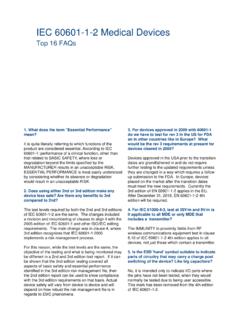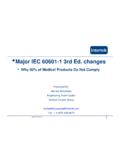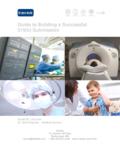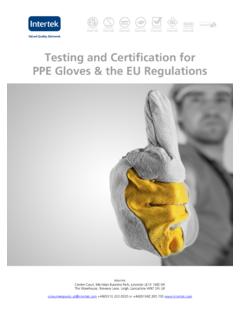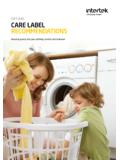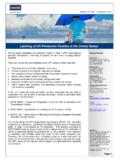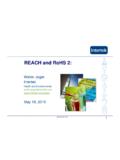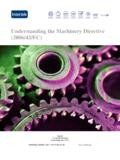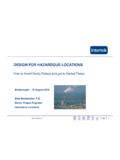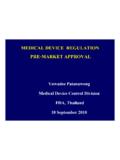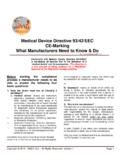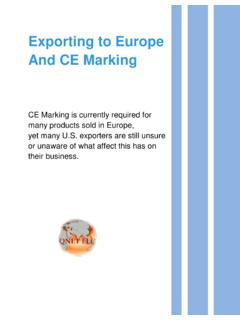Transcription of The Medical Device Manufacturer’s Guide to The …
1 Eva-Helena Ouchterlony Head of Chemistry, Health and Environmental Services/ intertek Sweden The Medical Device Manufacturer s Guide to The Recast RoHS Directive 2011/65/EU The Medical Device Manufacturer s Guide to the Recast RoHS Directive 2011/65/EU 2 Contents Contents .. 2 Introduction .. 3 Background .. 3 Scope Expansion .. 5 Terms and Definitions .. 7 Substance Restrictions .. 8 Exemptions .. 9 CE Marking and Alignment with the New Legislative Framework (NLF) .. 10 Summary and Conclusion .. 11 How intertek Can Help .. 12 About intertek .. 13 Contact Us .. 13 Appendix 1 .. 14 The Medical Device Manufacturer s Guide to the Recast RoHS Directive 2011/65/EU 3 Introduction The European Union s RoHS Directive 2002/95/EU has undergone major changes in terms of scope, definitions, and newly introduced methodologies and procedures.
2 The recast RoHS Directive 2011/65/EU, also known as RoHS 2, was published in the Official Journal in July 2011, and transposed into EU national law in January, 2013, and the former Directive has been repealed. As a manufacturer, importer or distributer it is important to understand and fulfil the obligations of the recast RoHS Directive. This white paper will go through the main changes of the Directive and discuss its potential impact on industry. Background The former RoHS Directive, 2002/95/EU, entered into force in July 2006. The main purpose of the Directive was to restrict Lead, Cadmium, Hexavalent Chromium, Mercury and Polybrominated Biphenyls (PBB) and Polybrominated Diphenylethers (PBDE) in electrical and electronic equipment (EEE). The reason for restricting these substances is that they may be released into the environment where they pose a threat to human and animal health and the environment, especially when reaching the waste treatment stage.
3 The potential risks are further increased if sub-standard recycling/recovery processes are used. Since 2006, enforcement and market surveillance has shown that a high percentage of EEE entering the European market is non-compliant with the requirements of RoHS, the products tested have been found to contain concentrations of the restricted substances above the set legal limits. The former RoHS Directive also posed challenges for the industry in the way it was written. It was considered complicated in terms of how to demonstrate compliance to the substance requirements and also in terms of definitions and the scope. To define product categories in scope, the former Directive made a reference to Annex 1A of the WEEE Directive (2002/96/EC on Waste of Electrical and Electronic Equipment).
4 The WEEE Directive in turn, gave the Member States a certain degree of freedom in interpretation when it came to adding products to the categories in scope. As a consequence, the scope of both WEEE and RoHS has varied between Member States. These differences in interpretations of scope as well as enforcement methodologies in the Member States have given rise to uncertainty as to what is covered by the legislation and added to the administrative burdens and unnecessary costs of manufacturers . The Medical Device Manufacturer s Guide to the Recast RoHS Directive 2011/65/EU 4A revision mandate set out in the former RoHS Directive (article 6) and the Commission s commitment to developing a better regulatory environment have formed the basis of a review of both the Directive s implementation and its potential expansion in terms of new product categories as well as an adaptation of the substance list.
5 The objective of the review was to improve the implementation and to harmonize enforcement of RoHS requirements while minimizing the risk to human health and the environment, decreasing the administrative burden, and increasing cost effectiveness. Based on the review, a recast Directive was presented in 2011, containing substantial changes to address both the problems seen with the first RoHS Directive, as well as the implementation and expansion of the Directive. Key Changes The key changes to the recast RoHS Directive include: scope - the inclusion of new product categories the introduction of new terms and definitions the introduction of a methodology for review of existing restricted substances and the introduction of new restrictions a clearer procedure for granting exemptions alignment with the New Legislative Framework (NLF) including CE Marking The Medical Device Manufacturer s Guide to the Recast RoHS Directive 2011/65/EU 5 Scope Expansion RoHS 2 is now a standalone Directive and has no link to the WEEE Directive.
6 Instead, the categories in scope are listed in Annex I of the RoHS Directive. The scope of RoHS still covers the eight product categories included in the original scope, categories 1-7 and 10 listed in the WEEE Directive (2002/96/EC). In 2006, a study was performed to assess the possible inclusion of categories 8 and 9 of the WEEE Directive, namely Medical devices and monitoring and control instruments, into the scope of RoHS. The study supported the inclusion of the two categories, and the RoHS Directive now includes Medical devices and monitoring and control equipment. Compliance dates for Medical devices , in vitro diagnostics, and industrial monitoring and control instruments placed on the market are July 22, 2014, July 22, 2016, and July 22, 2017, respectively. Active implantable Medical devices and devices critical to an implantable Device 's operation remain exempt from the 2014 compliance date.
7 An additional category, category 11, was also included into the scope of RoHS. This category, entering into force in July 2019, will cover electrical and electronic equipment not covered by the other categories. With the inclusion of category 11, the RoHS Directive will have an open scope, including all EEE unless specifically excluded. Medical Device manufacturers and RoHS 2 Europe is getting serious about its environmental protection. It will soon be nearly impossible for Medical Device manufacturers to sell their products into the European Union without full compliance something that is also catching on in China, Japan, India and other nations. This is part of a larger trend toward increased environmental regulation worldwide. You can be assured the authorities will be reviewing technical files for RoHS 2 compliance beginning July 22, 2014.
8 RoHS 2 Directive Scope 1. large household appliances 2. small household appliances 3. IT and telecommunications equipment 4. consumer equipment 5. lighting equipment 6. electrical and electronic tools 7. toys, leisure and sports equipment 8. Medical devices 9. monitoring and control instruments including industrial monitoring and control instruments 10. automatic dispensers 11. other electrical and electronic equipment not covered by any of the categories above Note: newly introduced categories are marked in bold The Medical Device Manufacturer s Guide to the Recast RoHS Directive 2011/65/EU 6In the case of Medical devices , which have increased testing and reliability requirements, the approximate yearly compliance cost is estimated to be 400-1600 million Euros. As a result, an important decision for Medical Device companies will be which products are still going to be available on the EU market after July 22, 2014.
9 Where to start? Considering that it will take an estimated 18 months or more to complete testing and validation for the most complex products, while obtaining approvals under the Medical Device Directives may take an additional 12 months, manufacturers are urged to start planning for RoHS 2 compliance immediately. Conformity information must be compiled into a technical documentation file based on requirements outlined in several legislative documents, standards, and industry best practices. This will require a continuous exchange of information in the entire supply chain. Examples of documents included in a RoHS 2 technical file are: conformity risk assessment supplier declarations of compliance materials declarations results of supplier audits chemical analysis results Examples of relevant resource documents include: Directive 2011/65/EU Decision No 768/2008/EC of the European Parliament and of the Council of 9 July 2008 on a common framework for the marketing of products, and repealing Council Decision 93/465/EEC Regulation (EC) No 765/2008 of the European Parliament and of the Council of 9 July 2008 setting out the requirements for accreditation and market surveillance relating to the marketing of products and repealing Regulation (EEC) No339/93 EN 62321.
10 2009, Electrotechnical products Determination of levels of sic regulated substances (lead, mercury, cadmium, hexavalent chromium, polybrominated biphenyls, polybrominated diphenyl ethers), which is adopted from IEC 62321 (which also may be used) The Medical Device Manufacturer s Guide to the Recast RoHS Directive 2011/65/EU 7 IEC/TR 62476 Ed , Guidance for evaluation of product with respect to substance-use restrictions in electrical and electronic products IEC 62474 Ed , Material Declaration for Products of and for the Electrotechnical Industry published March 1, 2012 Ideally, the requirements for technical documentation should be taken into account during the initial implementation of the restrictive substance control and during the conformity data collection. Taking an up-front approach will help Medical Device manufacturers avoid the need to re-do a portion of the conformity assessment due to incomplete or insufficient information.
